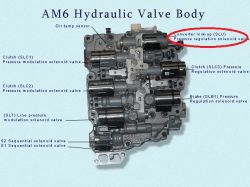FAQ
TL;DR: 258,000 km C5 AM6 shows a hot Reverse clunk that fades after 10 minutes; "only it happens on R." This FAQ explains scanner calibration and simple checks to restore smooth engagement. [Elektroda, Lysyxmv6, post #17253813]
Why it matters: It helps Citroën C5 MKII LIFT 2.0 HDi owners quickly triage and fix AM6 Reverse jerks without guesswork.
Quick Facts
- Vehicle/context: C5 MKII LIFT 2.0 HDi with Aisin AM6 at 258,000 km; Reverse-only harsh engagement after driving. [Elektroda, Lysyxmv6, post #17253813]
- Heat/cool pattern: The Reverse impact disappears after about 10 minutes of off-time. [Elektroda, Lysyxmv6, post #17253813]
- Control design: “There is no solenoid valve directly responsible for reverse gear.” [Elektroda, romuald-f, post #17256277]
- First step: “First, do a calibration with the scanner.” (transmission adaptation). [Elektroda, romuald-f, post #17255934]
- Don’t shotgun parts: “If you think that ASB repair involves replacing solenoid valves… [you’re] not an ASB mechanic.” [Elektroda, romuald-f, post #17256524]
Is there a dedicated Reverse solenoid on the Aisin AM6?
No. Reverse engagement on the AM6 is not controlled by a single solenoid. As one expert put it, “There is no solenoid valve directly responsible for reverse gear.” That means an R‑only jerk will not be solved by swapping a mythical “Reverse solenoid.” Focus on diagnosis rather than guessing a single valve. [Elektroda, romuald-f, post #17256277]
Why does my C5 jerk only when selecting R after a drive, not when cold?
In the reported case, gear changes were smooth before warming, and only Reverse produced a strong blow after driving. The behavior then disappeared after about 10 minutes with the car off. This pattern points to condition‑dependent behavior, not a constant fault. Use the calibration guidance below as your first action. [Elektroda, Lysyxmv6, post #17253813]
What�s the first step to fix a Reverse clunk on AM6?
Run a transmission calibration using a scanner. The guidance was clear: “First, do a calibration with the scanner.” How-To:
- Warm the drivetrain to normal temperature.
- Connect a compatible scanner and select gearbox adaptation/calibration.
- Follow on‑screen prompts to completion, then recheck Reverse engagement.
This establishes baseline control parameters before any parts decisions. [Elektroda, romuald-f, post #17255934]
Do I need to calibrate after replacing any solenoid or valve body parts?
Yes. After replacing a solenoid, perform a computer-guided calibration. The pointed follow-up in the thread was, “After replacing the solenoid, did you calibrate the transmission with a computer?” Skipping adaptation can leave fill times and pressures misaligned, causing harsh engagements. Always recalibrate before further conclusions. [Elektroda, romuald-f, post #17254476]
Should I replace solenoids to cure an R-only jerk?
No. Blind solenoid replacement is not proper automatic transmission repair. As an expert warned, “If you think that ASB repair involves replacing solenoid valves… [you’re] not an ASB mechanic.” Start with scanner calibration and structured diagnostics before touching hardware. This avoids needless cost and risk. [Elektroda, romuald-f, post #17256524]
Can Lexia/Diagbox perform the AM6 calibration?
Use a scanner capable of AM6 adaptation; the guidance was to calibrate “with the scanner.” If your tool supports the AM6 functions, run its gearbox adaptation program. Follow the on‑screen sequence precisely and verify after. If unavailable, use another compatible diagnostic platform. [Elektroda, romuald-f, post #17255934]
Is a brake band the likely cause of an R jerk here?
The discussed advice did not point to a brake band. The recommended first step was to perform a scanner calibration. Complete adaptation before suspecting mechanical hardware. This approach reduces unnecessary teardown and targets control issues first. [Elektroda, romuald-f, post #17255934]
Does the issue happen when cold on this 258,000 km C5?
No, in the reported case it did not. The driver noted that, before driving and warming up, selecting D or R at a standstill produced no disturbing symptoms. The harsh Reverse engagement appeared only after a drive. Mileage was stated as 258,000 km. [Elektroda, Lysyxmv6, post #17253813]
Does the symptom clear after a cooldown period?
Yes, in this case it did. After about 10 minutes, the driver selected Reverse again and there was no impact. This edge case shows an intermittent condition that can mask itself after short cool-downs. Verify with multiple checks after calibration. [Elektroda, Lysyxmv6, post #17253813]
What does "calibration" mean in this context?
Calibration is a scanner-guided adaptation that re-establishes control parameters for the AM6. You run it with a diagnostic computer, following the tool’s instructions start to finish. It is the advised first action before parts replacement or teardown. “First, do a calibration with the scanner.” [Elektroda, romuald-f, post #17255934]
Is Drive (D) engagement affected too?
In the reported case, no. The driver wrote that the car changed gears smoothly, and the strong blow appeared only on selecting Reverse after driving. Drive engagement at a standstill showed no disturbing symptoms when cold. This helps isolate the complaint to Reverse selection. [Elektroda, Lysyxmv6, post #17253813]
Should I start with software adaptation before any mechanical teardown?
Yes. The guidance prioritized software adaptation. As stated: “First, do a calibration with the scanner.” This establishes whether control parameters caused the harsh Reverse engagement. Only after a correct adaptation should you consider hardware investigation. It saves time and avoids unnecessary costs. [Elektroda, romuald-f, post #17255934]



